Casino Architecture: The Impact of Design on Player Experience
Casino design psychology fundamentally shapes how players interact with gaming environments through meticulously planned architectural elements. The sophisticated integration of spatial planning and environmental psychology creates powerful effects on visitor behavior and gaming engagement.
Strategic Layout and Flow
Maze-like pathways and curved corridors guide visitors through carefully orchestrated spaces, while counterclockwise circulation patterns maximize exposure to gaming areas. The architectural layout deliberately controls sightlines and movement, creating an immersive journey through the gaming floor.
Environmental Controls and Sensory Design
Casino atmospherics employ precise control over temperature, humidity, and air quality to maintain optimal player alertness and comfort. Rich color psychology utilizing deep reds and golds triggers excitement and energy, while strategic lighting design enhances the gaming atmosphere. Winning sound effects and ambient music stimulate dopamine responses, reinforcing positive gaming experiences.
Architectural Elements for Enhanced Gaming
Low ceiling heights in gaming areas create intimate spaces that focus attention on gaming activities. High-pile carpet design subtly influences movement patterns and reduces fatigue, while acoustic engineering manages sound levels for maximum comfort. These architectural features work in concert to extend player engagement and enhance the overall gaming experience.
Through this sophisticated blend of design elements, casino architecture creates environments that captivate visitors and optimize the gaming experience, demonstrating the powerful intersection of design psychology and player behavior.
The Psychology Behind Casino Layout
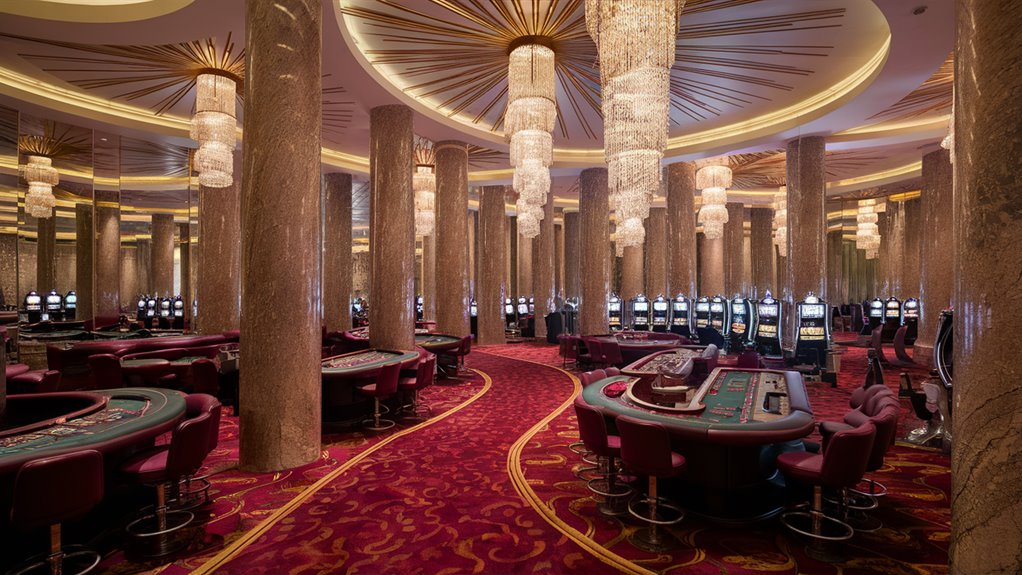
The Psychology Behind Casino Layout: A Strategic Design Analysis
Understanding Casino Floor Plans
Modern casino layouts represent masterful examples of behavioral architecture, utilizing scientifically-backed design principles to optimize the gaming experience.
The maze-like floor plans incorporate winding pathways that naturally guide visitors toward gaming areas while minimizing clear sight lines to exits.
Strategic Game Placement and Environment
High-stakes gaming zones occupy premium real estate near entrances and major thoroughfares, creating powerful engagement hotspots.
These carefully curated areas generate atmospheric energy through strategic positioning of popular slots and table games, enhanced by calculated ambient sound design.
Space Segmentation and Comfort
Casino floor segmentation employs lower ceiling heights and precision lighting to establish intimate gaming spaces.
These microenvironments create psychological comfort zones, encouraging players to claim their territory and settle into extended gaming sessions.
Traffic Flow and Amenity Positioning
The strategic placement of essential amenities – restaurants, bars, and restrooms – deep within the casino floor plan necessitates guest movement through gaming areas.
Directional carpet patterns subtly influence foot traffic while defining distinct spaces without physical barriers.
The deliberate absence of windows and timepieces works in concert with these architectural psychology elements to maintain an immersive atmosphere that optimizes player engagement and time spent gaming.
Environmental Psychology Elements
- Controlled lighting systems that maintain consistent illumination
- Acoustic engineering for optimal gaming ambiance
- Temperature-controlled environments for maximum comfort
- Strategic color psychology in décor and furnishings
- Calculated sight lines that draw attention to gaming options
Lighting and Color Manipulation
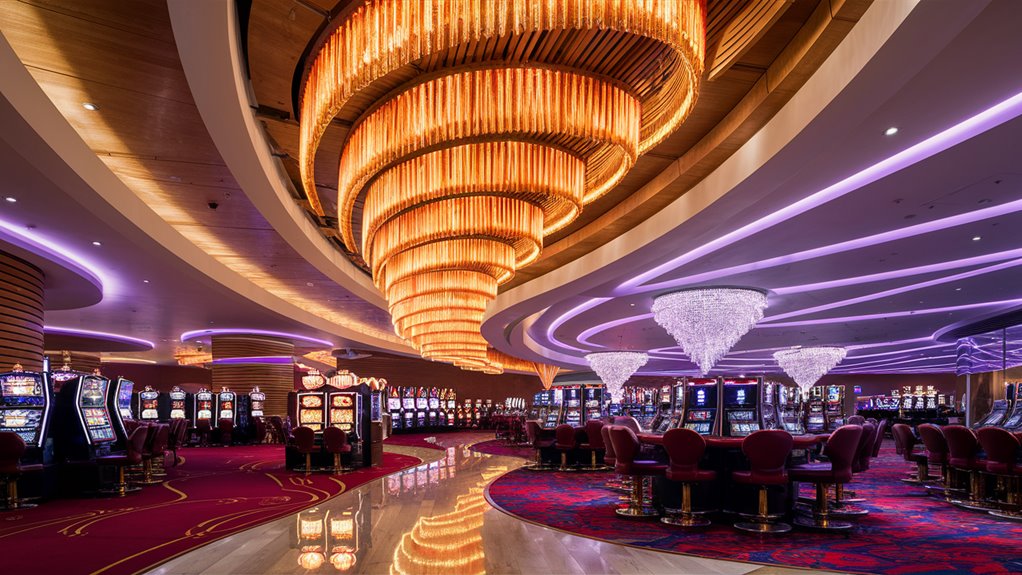
Casino Lighting and Color Design: Strategic Manipulation for Maximum Impact
Strategic Lighting Implementation
Casino lighting design serves as a sophisticated architectural tool that fundamentally shapes player experience and behavior.
Warm, calibrated illumination creates intimate atmospheres while maintaining optimal visibility for gaming activities.
The strategic variation in light intensity across different zones establishes distinct psychological spaces and directs attention to key gaming areas.
Color Psychology in Casino Environments
Strategic color implementation plays a crucial role in casino design psychology.
Rich reds and golds trigger excitement and energetic responses, while deep purples convey luxury and exclusivity.
High-end casinos integrate these colors into their floor patterns and carpeting designs, working in harmony with ambient lighting to influence traffic flow and cleverly conceal wear patterns in high-traffic areas.
Advanced Architectural Lighting Techniques
Ceiling height manipulation through sophisticated lighting represents a key design element in modern casinos.
Gaming zones feature lower, intimate ceiling treatments with focused lighting to create concentrated play environments.
Conversely, circulation areas utilize elevated, bright ceiling designs to facilitate movement and orientation.
Smart LED technology enables dynamic lighting adjustments throughout operating hours, maintaining optimal engagement levels and adapting to natural circadian rhythms.
Sound Design in Gaming Spaces
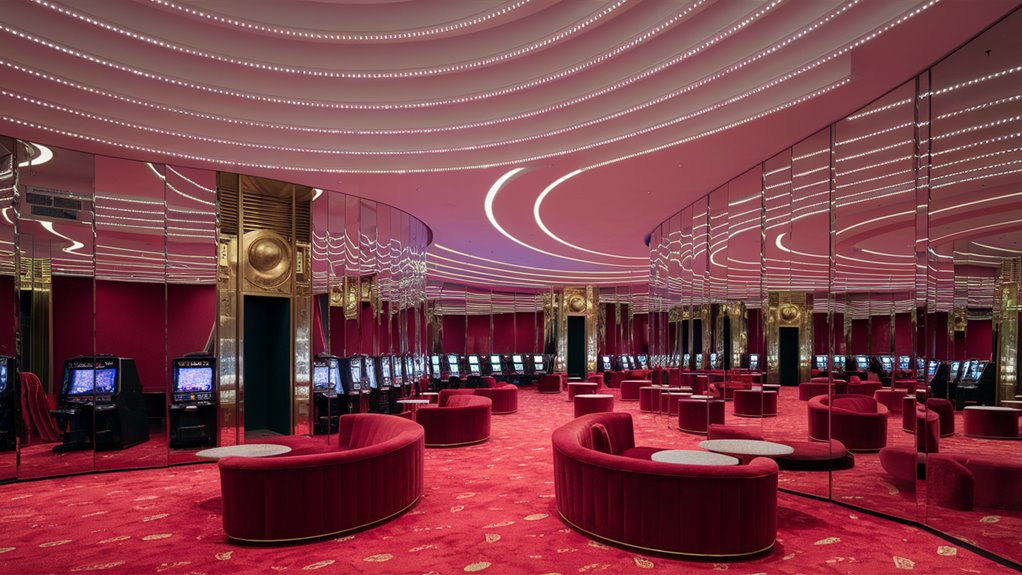
Sound Design in Modern Gaming Environments
The Acoustic Architecture of Casinos
Sound waves strategically flow through modern casino environments, forming sophisticated acoustic landscapes engineered to maximize player engagement.
The intricate layering of winning jingles, machine effects, and ambient music creates a constant mid-frequency atmosphere that maintains optimal alertness while ensuring player comfort.
Strategic Audio Zoning and Placement
Speaker positioning throughout gaming floors establishes distinct acoustic zones that serve specific purposes.
Slot machine areas feature carefully calibrated celebratory sounds at frequencies proven to trigger dopamine responses.
Table game sections maintain lower volume profiles, facilitating clear communication between dealers and players.
Architectural elements, including specialized carpeting and ceiling materials, precisely control sound reflection and absorption patterns.
Advanced Audio Technology and Environmental Control
Modern casino acoustics deliberately eliminate traditional temporal cues, enhancing player immersion through calculated sound design.
The transition to digital transactions has influenced acoustic planning, with sound masking techniques minimizing cash handling noise.
Directional audio systems create targeted sound environments, enabling distinct micro-environments across the gaming floor while preventing acoustic interference between spaces.
Key Sound Design Elements:
- Frequency optimization for maximum psychological impact
- Acoustic zoning for different gaming activities
- Environmental sound control through architectural design
- Digital integration with modern gaming systems
- Immersive audio targeting using directional technology
Traffic Flow and Path Design
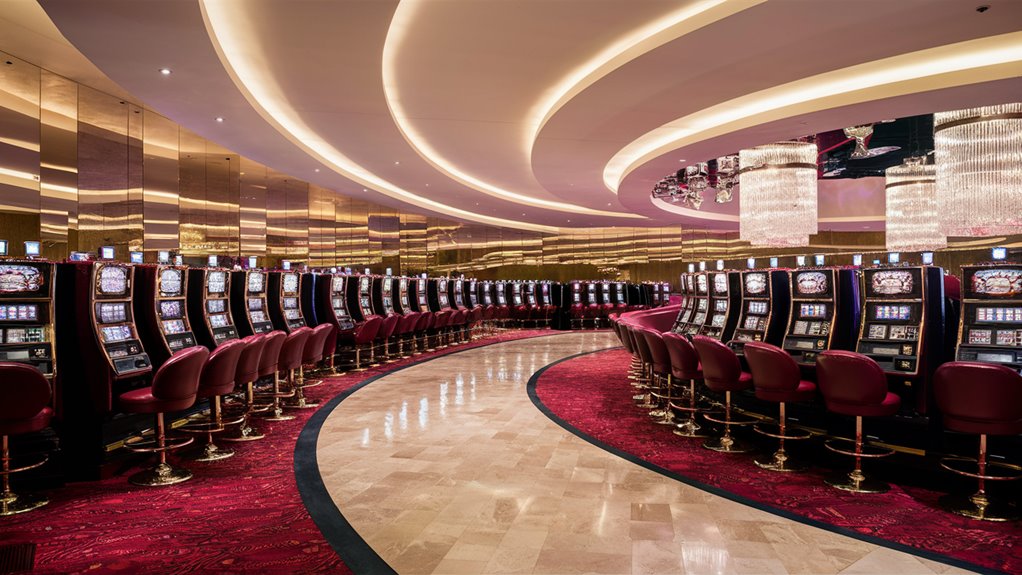
Casino Traffic Flow and Path Design Optimization
Strategic Layout Fundamentals
Modern casino floor plans leverage sophisticated traffic flow patterns that guide players through meticulously orchestrated pathways.
The maze layout design strategically arranges gaming areas while maintaining clear sightlines to key attractions and amenities, optimizing both player experience and revenue generation.
Path Design Elements
The cornerstone of effective casino circulation design includes primary corridors spanning 8-12 feet in width.
These main thoroughfares feature gentle curves rather than linear paths, creating discoverable spaces that naturally draw guests deeper into the gaming environment.
Strategic slot machine placement and gaming table positioning along these routes maximize player engagement.
Layout Optimization Techniques
Successful casino designs incorporate decompression zones at entrance points, facilitating visual adjustment and orientation for incoming guests 카지노사이트
The layout connects to key anchor points, including high-limit gaming areas and signature dining venues.
Traffic flow patterns typically follow a counterclockwise direction, with strategic service placement of essential facilities like cashiers and restrooms requiring guest movement through revenue-generating zones, enhancing gaming exposure and dwell time.
Key Design Features
- Curved pathways for natural exploration
- Strategic anchor point positioning
- Counterclockwise circulation patterns
- Service area integration for maximum gaming exposure
- Optimal sightline management
- Revenue-focused traffic routing
Architectural Elements Affecting Decision Making
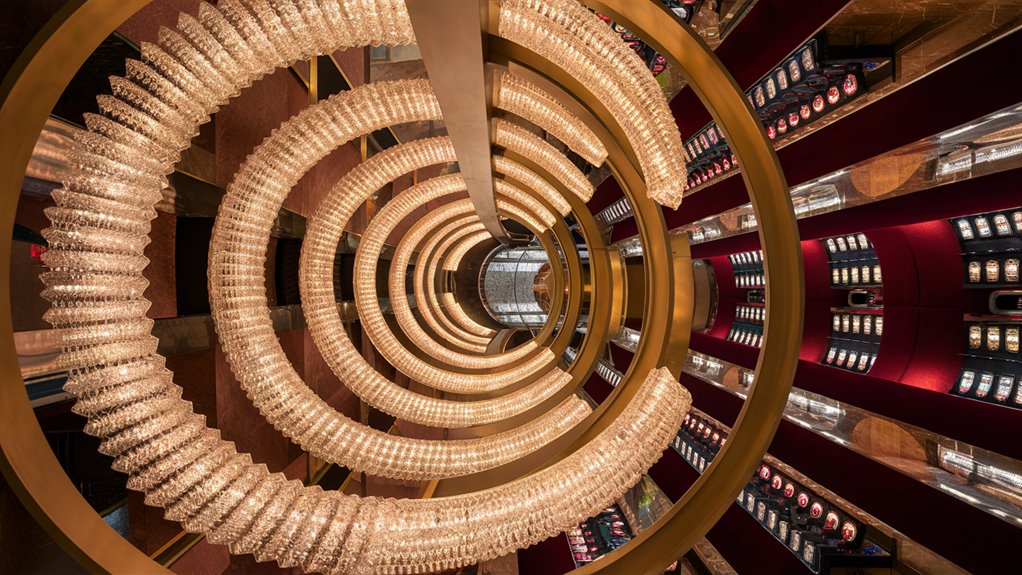
How Architectural Elements Impact Casino Decision-Making
Strategic Spatial Design Elements
Casino architecture fundamentally shapes player behavior through meticulously engineered environmental design.
Ceiling height variation serves as a powerful psychological tool – soaring heights in entrance areas create an atmosphere of grandeur, while lower ceilings above gaming zones promote focus and intimacy.
Structural elements like columns and walls function as subtle wayfinding devices, directing traffic flow while obscuring clear paths to exits.
Layout and Amenity Placement
The strategic positioning of bars, restaurants, and entertainment venues creates deliberate decision points throughout the casino floor.
These carefully placed architectural interruptions break direct pathways and encourage spontaneous gaming engagement.
Dynamic lighting design plays a crucial role in player psychology – bright, energetic illumination highlights high-action areas, while softer ambient lighting enhances the gaming experience at table games.
Material Selection and Environmental Psychology
Strategic material choices reinforce desired behavioral patterns within the casino environment.
High-pile carpeting naturally slows guest movement, while reflective surfaces command visual attention.
Acoustic engineering through sound-absorbing materials maintains optimal ambient noise levels.
Architectural framing elements like archways and soffits establish psychological boundaries that influence player stopping points and gaming area selection Expert Tips
Environmental Controls and Comfort Systems
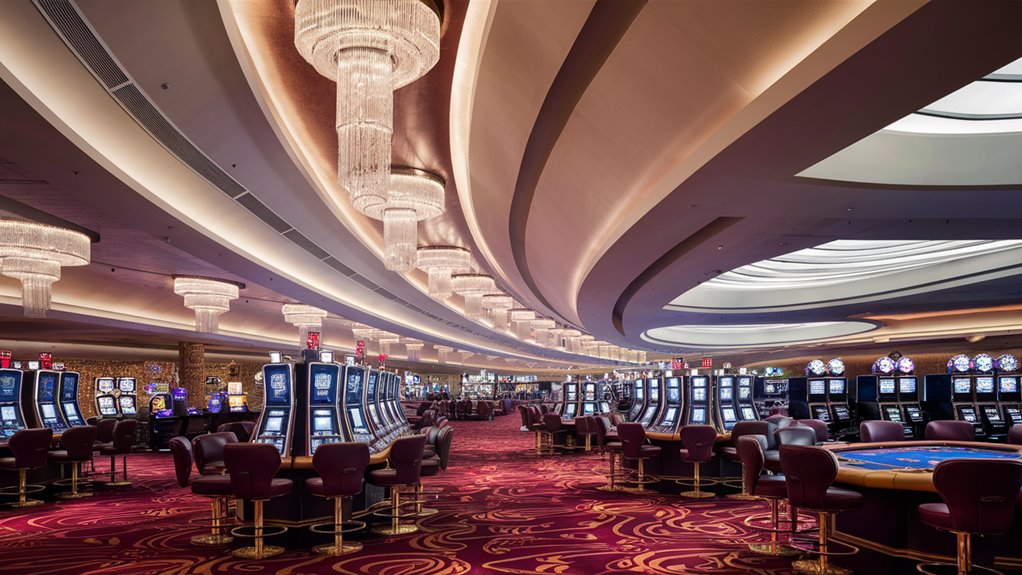
Casino Environmental Control Systems: The Ultimate Guide
Temperature Management and Player Comfort
Advanced environmental control systems serve as the foundation for optimal casino gaming experiences, operating continuously to maintain perfect conditions.
Casino temperature control typically maintains a precise range of 68-72°F (20-22°C), while relative humidity levels remain steady at 40-60%, creating an environment scientifically proven to enhance player alertness and comfort during extended gaming sessions.
Advanced HVAC and Air Quality Systems
State-of-the-art HVAC systems employ sophisticated air filtration and circulation technology, performing complete air volume replacement every 4-5 minutes.
These advanced filtration systems play a crucial role in smoke removal, air quality maintenance, and the creation of distinct atmospheric zones throughout the gaming floor.
Integrated Environmental Controls
Modern casino environmental systems seamlessly integrate lighting controls and acoustic management solutions.
Pressurized air distribution systems create effective air curtains between smoking and non-smoking sections while managing sound transmission across different gaming areas. These systems maintain distinct environmental zones without compromising the overall gaming atmosphere.
Real-Time Monitoring and Adjustment
Environmental control centers utilize cutting-edge technology to monitor crucial metrics including CO2 levels, particulate matter, and temperature gradients in real-time.
Automated adjustment systems continuously optimize gaming environments through precise micro-adjustments, maintaining optimal conditions while remaining undetectable to players.
